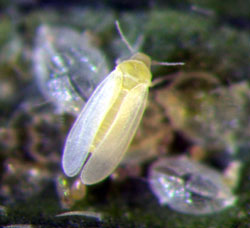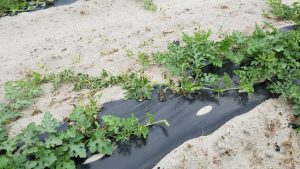Florida watermelon growers are constantly faced with the challenge of disease management. Whether it’s diseases vectored by whiteflies or fungal diseases such as fusarium wilt, once a crop is infected, the results can be detrimental.
Nicholas Dufault, assistant professor of plant pathology and Extension specialist at the University of Florida (UF) in Gainesville, has been studying ways growers can manage fusarium wilt. He said he mostly focuses on fusarium wilt because it is such a prevalent watermelon disease.
STRATEGIES FOR FUSARIUM WILT
A study Dufault completed in the 2017 season tested if delayed planting could help reduce the impact of fusarium wilt on watermelon. He found that planting about a month later than normal decreases the impact of fusarium wilt and increases yield. “We were able to manage the disease more by having later planting dates,” Dufault said.
According to Dufault, if growers have had fusarium wilt in their fields before, it is likely that the disease will come back, which leads into his next study.
Dufault wanted to see if he could test a field for fusarium wilt before the watermelons were planted. This would tell the grower the likelihood of the crop becoming infected with the disease if it were to be planted in the tested field. His preliminary studies performed during the 2016 season revealed positive results. “We were able to see that fusarium wilt was there in the field, and it did show up when we planted in that field that year as well,” Dufault said.
Dufault said testing could be a good tool for growers who are thinking about planting on a field that has not been planted with watermelon for several years. “We’re hoping if we have this opportunity for growers who have had six, seven, maybe even eight years of a rotation where they have not had cucurbits in that field plot, we can go in, take a sample from where they know they have had fusarium wilt in the past — or just randomly sample around the field — and give them an idea if the pathogen is still present after that rotation,” Dufault explained.
Based on positive results from his preliminary study, Dufault believes biopsies can indicate whether or not fusarium wilt is present in a field. As for finding out the quantity of the disease, that would depend on where samples are taken and how much is sampled. However, Dufault said he thinks finding out the quantity of the disease in a field will require too much sampling to get accurate results.
WHITEFLY WOES
 Another pressing disease issue for Florida watermelon growers has been whitefly-transmitted viruses. Mathews Paret, UF associate professor in plant pathology at the North Florida Research and Education Center in Quincy, said whitefly-transmitted viruses have been at the top of his radar.
Another pressing disease issue for Florida watermelon growers has been whitefly-transmitted viruses. Mathews Paret, UF associate professor in plant pathology at the North Florida Research and Education Center in Quincy, said whitefly-transmitted viruses have been at the top of his radar.
Paret said his lab worked with UF cooperative Extension as well as the U.S. Department of Agriculture’s Agricultural Research Service in 2016 and 2017 to look at fruit quality issues in watermelon. Most of the watermelons tested were produced in the fall, which is not the typical season for watermelon since it is usually a spring crop. Paret said what he consistently found in the fall watermelon, and in some cases the spring watermelon, was fruit-quality issues. “When they were ready to be harvested or to be shipped, you cut it open and there’s yellow flesh inside, which is not marketable. Also, sometimes white tissue inside the red flesh, which is not marketable,” Paret said.
According to Paret, he was unsure where these problems in fruit quality were coming from. However, he noticed that after examining this issue further, one commonality these watermelons shared was heavy whitefly pressure in their fields.
Paret then collected samples of infected fruits and leaves. They all showed signs of viral infection. The two pathogens that Paret and collaborators consistently found were cucurbit leaf crumple virus and cucurbit yellow stunting disorder virus. These two viruses are both transmitted by whiteflies.
Dufault and Paret are both keeping an eye on whitefly-transmitted diseases in the 2018 spring season. “I am looking at cucurbit leaf crumple virus and cucurbit yellow stunting disorder virus as the two highly relevant viruses,” Paret said.
Paret believes if Florida has a cold winter, growers may see whitefly pressures decrease. “We might have less risk this coming spring, but it depends on the weather,” he said.
Dufault will be watching whitefly populations in 2018 as well. “If the whitefly population doesn’t go down, it will be a problem,” he concluded.
See more articles like this in VSCNews magazine. Click here to subscribe today.
Share this Post











